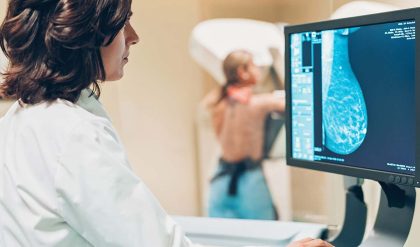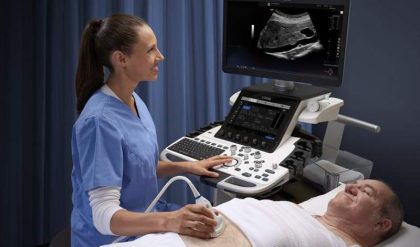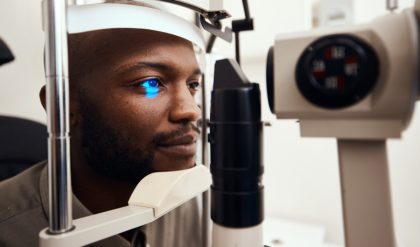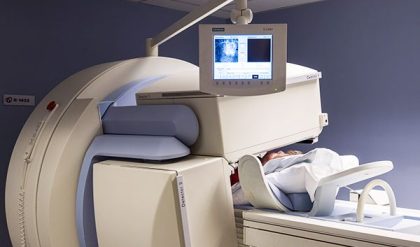Mammography is a specific type of X-ray imaging that uses a low dose X-ray system (Figure 1)1 specially designed for creating detailed images of the breast known as mammograms (Figure 2)2.
Mammography is either used as a screening tool to detect early breast cancer in women without signs or symptoms of breast disease or to diagnose a breast disease in women with symptoms such as a lump, pain or nipple discharge.

Fig. 2: Normal breast tissue as it appears on a mammogram
Digital mammography, also known as full-field digital mammography (FFDM), uses electronic detectors that convert X-rays into electrical signals. The images of the breast can be viewed on a computer screen. Advanced developments in mammography enable considerable reductions in the required radiation dose. For example, digital mammography itself can reduce the dose by up to 50% compared with a conventional film mammogram. New software is also available that can further reduce the dose by up to 30% while maintaining the same image quality.
One of the most promising developments in mammography is digital breast tomosynthesis (DBT), which provides 3D images of the entire breast. Conventional 2D mammography produces a single image of the breast, where overlapping breast tissue can either mimic or conceal lesions. Digital breast tomosynthesis (DBT) acquires and combines breast images from multiple angles and creates a 3D rendering of the entire breast. This is displayed as a series of slices, showing one tissue layer after the other to reduce overlapping of the breast tissue. This new technology has already been shown to detect up to 43% more breast cancers than with conventional 2D mammogram.3
Screening Mammography
Breast cancer is the most common cancer in women worldwide. The earlier breast cancer is detected, the better the chances of a cure and treatment with breast conserving therapy. Because mammography allows early detection of breast cancer, many countries have established screening programs for women who do not have any signs or symptoms of breast cancer.
For routine breast screening, two pictures are taken of each breast and a radiologist interprets the mammograms.
Modern screening mammography emits an extremely low dose of radiation, so health risks from screening mammography are unlikely and the benefit of early detection of cancers is considered to outweigh these very low risks.
Diagnostic Mammography
Diagnostic mammograms are used to check for breast cancer after a lump or other symptom has been identified, possibly by a screening mammogram.
Diagnostic mammograms focus in particular on an area of abnormal tissue and may take longer than screening mammograms. This is because multiple images may be taken to achieve an accurate diagnosis. In addition to mammography, other methods such as ultrasound or MRI may also be used.
If the abnormal tissue appears to be a cancer, the only way to confirm this is with a biopsy. That is to extract some tissue from the lump and examine it under a microscope. This is often done with a biopsy needle.
Mammography, ultrasound or MRI may be used to guide the needle in the breast for an optimal biopsy sample.
Modern screening equipment is specially designed to emit an extremely low dose of radiation and the chances that a mammogram will cause a cancer to develop are therefore extremely low. The benefits in terms of the number of cancers detected far outweigh the low risks of mammography.




